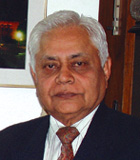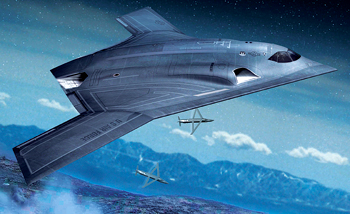INDIAN ARMED FORCES CHIEFS ON
OUR RELENTLESS AND FOCUSED PUBLISHING EFFORTS

SP Guide Publications puts forth a well compiled articulation of issues, pursuits and accomplishments of the Indian Army, over the years

I am confident that SP Guide Publications would continue to inform, inspire and influence.

My compliments to SP Guide Publications for informative and credible reportage on contemporary aerospace issues over the past six decades.
Massive Victory for Northrop
With the award of the $80 billion contract for the LRSB, Northrop Grumman, believed to have been on the verge of a break-up, will now be able to avoid being taken over by one of the US aerospace majors and can now look forward to a bright future
 | By Air Marshal B.K. Pandey (Retd) Former Air Officer Commanding-in-Chief of Training Command, IAF |

On October 27 this year, the Pentagon awarded a contract to the US aerospace major Northrop Grumman to build the new Long Range Strike Bomber (LRSB). A massive victory and historical milestone in aerospace and defence sector. The fleet of aircraft of this class currently operational with the United States Air Force (USAF) consists of three types of platforms. The oldest is the B-52 Stratofortress that was built by Boeing and has been in service with the USAF since the 1950s. Later to be inducted in the early 1980s was the B-1 designed and developed by Rockwell and soon replaced by an improved version, the B-1B which entered service in 1986 with the Strategic Air Command of the USAF as a nuclear capable platform. However, it is understood that the B-1B is no longer certified to have the capability of delivering nuclear weapons. The parent company Rockwell that built the B-1B bomber was ultimately taken over by Boeing. The third and the latest bomber aircraft to be inducted has been the Northrop B-2 Spirit, also known as the Stealth Bomber. This platform has been built by Northrop which became Northrop Grumman after merger with Grumman Aerospace Corporation in 1994.
The production of this aircraft was scaled down from 132 to 21 and today, a total of 20 B-2 Spirit bombers remain in service with the USAF. Although the B-2 fleet has been operational in the USAF for more than two decades, it still has considerable service life left and is expected to continue in service till at least 2058 with possibly major midlife upgrade. Other than the 20 B-2 Spirit bombers, the two other fleet of the B-52 and the B-1B, have far outlived their expected service life and have been overtaken by obsolescence. Also, as their technology is outdated, these two fleets are afflicted by age-related issues. Thus, these two fleet of long-range strike aircraft do require replacement if the USAF is to maintain its supremacy in global conventional as well as nuclear strike capability.
The USAF needs to always possess such a strategic reach not only to target any part of the world as dictated by the compulsions of national security but also to wield an effective deterrent capability. Induction of the next-generation bomber aircraft is therefore an urgent requirement of the USAF and would be a strategic investment for national security for decades to come. Quite understandably, this project figures on the top of their list of priorities for re-equipment.
The Industry in a state of flux
While there has been considerable excitement and optimism generated over the decision by the Pentagon to award the contract for the next-generation LRSB, developments during the last few years in the regime of fighter aircraft production by the US aerospace industry have not been as inspiring. The F-22 Raptor air superiority fighter aircraft programme of Lockheed Martin which was and continues to be a platform unmatched by any other in the world even today, was closed down somewhat prematurely in 2012 seven years after the first aircraft was inducted into the USAF. As against a requirement of 750 aircraft projected initially by the Pentagon, a total of only 187 were finally produced with the last aircraft being delivered to the USAF in 2012.
Apart from the perpetually escalating cost of the programme that has made the platform unaffordable even for the US Government, there was heated debate on the lack of clarity on the adversary or adversaries for whom this platform had been conceived. Robert Gates, the then US Secretary of Defense, espoused the change in strategic thinking at the Pentagon wherein the F-22 Raptor was seen as having been designed to fight wars of the 20th century between the superpowers and was not considered to be relevant to the type of conflicts in which the US was likely to be involved in the future.
Opinion in the US political and military leadership was clearly in favour of the more versatile and then thought to be less expensive option – the F-35 Lightening II, Joint Strike Fighter programme launched by Lockheed Martin. Unfortunately, the F-35 programme has been plagued with problems including serious technical glitches at every stage, missed timelines and heavy cost escalation, all casting serious doubts about its reliability and successful attainment of full operational status as was mandated in the initial plan for the design. However, despite the problems, development of three versions of the F-35 for the USAF, the US Navy and the US Marine Corps, continues. But the project has acquired the dubious distinction of being the most expensive fighter aircraft acquisition programme of the US armed forces.
The higher echelons in the leadership of the nation, especially in the domain of defence, were also of the view that air combat was a relic of the past and that the F-22 Raptor was an overkill as in the future, the possibility of full scale wars was remote. Instead, in the future, wars would be fought against small groups of guerrillas, the type of war currently going on in the Afghanistan-Pakistan region for which unmanned combat aerial vehicles (UCAVs) would be the platform of choice. In conformity with this philosophy, the USAF is expanding its fleet of unmanned platforms rapidly and every year, training more operators of unmanned aerial vehicles (UAVs) than fighter pilots. In fact, in 2009, there was wide consensus in the Pentagon that in all likelihood, the F-35 would be last manned fighter aircraft that the USAF would get. This philosophy, however, does not as yet seem to have pervadedthe regime of manned long-range strike aircraft as so far, there has been no indication that the LRSB would be an unmanned platform.
Implications for the us Aerospace Industry
Boeing and Lockheed Martin have been the two leading aerospace companies in the US with Northrop Grumman, often regarded as the ‘underdog’, placed in the third slot. To respond to the LRSB tender, Boeing and Lockheed Martin had teamed up to submit a joint bid. However, given the fact that Northrop Grumman had built the B-2 Spirit Bomber for the USAF and the fleet is expected to continue to be in service with the USAF for several decades more, award of the $80 billion contract to develop the fifth-generation LRSB which could possibly be named as the B-3, does not militate against logic. The manufacturer of the power plant is yet to be disclosed.
While this contract has definitely come as a bonanza for Northrop Grumman, it will also have a profound impact on the US aerospace industry which might witness some more acquisitions and mergers as was the case of Lockheed Martin’s acquisition of Sikorsky. In the face of declining contracts for defence equipment, the competition is becoming far more intense in the aerospace and defence industry in the US. Owing to the absence of large-scale new orders that the wars, including the Cold War, had generated, there is a now degree of distress in the industry as it has been facing an uncertain future.
However, with the award of the new multibillion-dollar contract for the LRSB, Northrop Grumman, believed to have been on the verge of a break up, will now be able to avoid being taken over by one of the US aerospace majors and can now look forward to a bright future. As for its rivals, Lockheed Martin would be involved with the F-35 programme for which the order from the three services i.e. the USAF, the US Navy and the US Marine Corps, taken together is indeed very large. For Boeing, contracts for the production of fighter aircraft are fast approaching completion and partial good times for the company can be expected only if orders for the F/A-18E/F Super Hornet continue to flow in.
In any case, as things stand, on account of lack of new orders, Boeing is not likely to maintain its combat aircraft manufacturing capacity beyond the end of this decade unless new programmes are initiated by the Pentagon, which at this point in time appears somewhat unlikely. The one possibility that is latent in the demand for the development and production of a next-generation fighter trainer for the USAF which would be required in sufficiently large numbers.
Conclusion
The fifth-generation bomber contracted to be designed, developed and built by Northrop Grumman, will be the main pillar of strength that will help the USAF play its role in the execution of US national defence strategy. It will give the USAF unprecedented capability of conventional as well as nuclear strike to neutralise targets in any part of the world. The threat to national security of the US is expected to emanate primarily from China and possibly Russia. However, there are two imponderables that Pentagon must address. The first that lies in the domain of finances pertains to cost escalation that may drive the project beyond the limits of affordability as witnessed in the F-22 and the F-35 projects. The second pertains to the issue of survivability in a highly intense air defence environment that the prospective adversaries are likely to develop in their own national security interests in the future.





